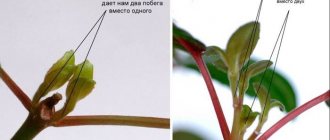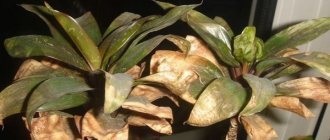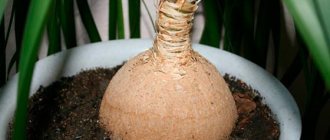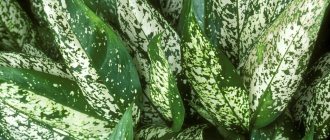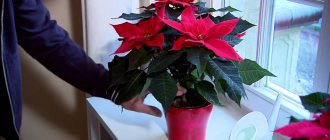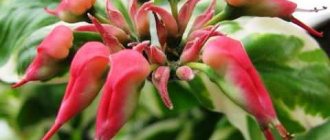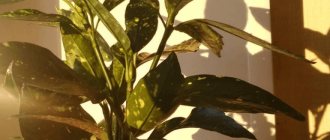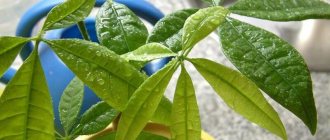Description of the appearance and origin of Cordyline
The proud-sounding name cordilina, in fact, is translated from Greek very prosaically - knot. But the plant itself looks very elegant thanks to its lush, brightly colored leaves.
Cordyline can be found in nature in both hemispheres. But to be more precise, only in tropical and subtropical climate zones. Asia, Australia, New Zealand and Brazil - in these countries, cordyline grows in the form of spreading trees, reaching large heights - up to 15 m.
The tropical resident cordyline is found in both hemispheres
Cordyline is classified as a false palm and is often confused with dracaena. And although these 2 plants are very close to each other, there are differences.
- Cordyline leaves have a petiole, which is absent in dracaena.
- The structure of the roots also varies. The root system of Cordyline is covered with nodes and swellings (which is why the plant got its name), and is white when cut. Dracaena has straight roots, and the cut is yellow or orange.
- And perhaps the main difference is the number of seeds. Cordyline fruit has from 4 to 20 seeds. Dracaena has only one thing.
Dracaena and Cordyline are close relatives
In indoor floriculture, cordyline is a bush-like plant that grows up to a meter in height. Of course, Cordyline is rather large in size, so it needs sufficient space. In a greenhouse, it can easily overcome the 1.5 meter bar.
The leaves of the plant differ in size and color. Depending on the type, the leaf blade can be narrow linear, broadly lanceolate or saber-shaped. The length varies from a few centimeters to a meter. The edge of the leaf can be completely smooth or have fine jagged edges. The main background of the sheet is green. And then nature begins to fantasize, applying stripes and strokes of yellow, red, pink and purple to the surface. White color looks very elegant.
The bright leaves of Cordyline are the main decoration of the plant, but their shape and color depend on the type and variety.
The plant blooms very interestingly. The inflorescences are large and dense panicles, the length of which can reach up to 1 m. Small flowers are painted creamy white, red or purple. In home floriculture, cordyline is grown as an ornamental foliage plant, because it practically does not bloom in the room.
In nature, cordyline blooms at the age of 8–11 years.
Long ago, James Cook called Cordyline the cabbage tree. It turns out that the local population actively used the young leaves of the plant for food. Old fibrous leaves are used to weave mats, rugs, and make brushes.
Cordyline is considered a rather unpretentious green pet. People who are just thinking about growing flowers may well purchase this plant in order to learn the basics of indoor floriculture with its help. Cordilina will easily forgive some mistakes and shortcomings that were made by accident, but quickly eliminated. But if you forget about the flower for a long time, it may die.
Growing cordyline is not difficult, the main thing is not to forget about it for a long time
Trimming
Cordyline is not prone to forming side shoots. If you want to stimulate it to form new leaves and get a denser leafy crown, you should periodically prune the weakest shoots.
In an adult bush, to rejuvenate it and obtain material for propagation, the top of the bush or side shoot is cut off. This fragment should be slightly woody (not green, but light brown), at least 10 cm in size, with three or more leaves. Use a clean, sharp knife or pruning shears for cutting. The cut area is sprinkled with crushed activated carbon.
After 2 weeks, young shoots should appear on the cut. The cut top is placed in water or in a damp mixture of sand and peat for rooting. After the roots appear, it is planted in a small pot. (See section Reproduction)
Types and varieties
There are more than 15 species of cordyline found in nature, but not all of them are suitable for growing at home. Breeders, based on the most adapted ones, have bred a sufficient number of varieties that get along quite well in the microclimate of an ordinary apartment.
Varieties common in indoor floriculture - table
| Types and varieties | Description |
| Cordyline southern or Australian | In nature it reaches 12 m in height and resembles a palm tree in appearance. The leaves, similar to narrow swords, reaching 90 cm in length and 7 cm in width, are collected at the top of the plant in the form of a bunch. Meter-long paniculate inflorescences consist of white fragrant flowers. |
| Cordilina Tricolor | A variety of cordyline apex. The leaves have a wonderful tri-color color, combining cream, green and pink. |
| Cordyline straight or compressed | It has a tall, straight stem, reaching 3 m in height, covered at the bottom with the remains of dying leaves. The linear or lanceolate leaf blade has slightly jagged edges and is green or purple in color. Leaf length 60 cm, width 3 cm. Loves cool rooms. |
| Cordyline fruticosa, bushy or apical | The trunk, thin up to 1.5 cm in diameter, sometimes has branches. The leaf shape is lanceolate, length 50 cm, width 10 cm. The petiole is grooved, its length is 15 cm. Veins stand out on the leaf plate. In nature, fruticose is colored green, but various varieties are much brighter. The leaves have stripes of various colors - crimson, red-brown, purple, light pink. The inflorescence is a loose panicle. |
| Cordilina Kiwi | Bushy lush plant. Dark green leaves with longitudinal yellowish stripes, 8 cm wide, have a crimson border. |
| Cordyline rubra or red | Cultivated as a valuable ornamental plant, it is called palm lily. Bush form, not exceeding 4 m in height. Leaves are leathery, slightly concave, lanceolate, up to 50 cm long and up to 4.5 cm wide. The color of the leaf blade is dark green with a hint of red. Blooms in summer with lilac flowers. |
| Cordilina purpul compacta | This is a miniature variety that has lush foliage colored purple-green. The stem is small but strong. |
| Cordilina chocolate queen | A very exquisite plant. The leaves are wide and elongated, painted with stripes of white, chocolate, lilac and several shades of green. |
| Cordilina snow | White stripes and streaks add sophistication to the green leaves of this variety. |
| Cordilina mix | This is not the name of a single variety, but of different types and varieties collected on one pallet, united by one name, which denotes a mixture of something. |
Magnificent types and varieties of Cordyline in the photo
Cordilina mix
Cordyline Lord Roberts
Cordilina chocolate queen
Cordilina purple compacta
Cordyline rubra or red
Cordilina kiwi
Cordyline fruticosa, bushy or apical
Cordyline straight or compressed
Cordilina tricolor
Cordyline southern or Australian
Description of the plant
Cordilina is a representative of the Asparagus family. In nature, it is found in all regions with subtropical and tropical climates.
This is a tree or shrub with thick and strong roots and lanceolate, sword-shaped or linear leaf blades.
Attention! At home, cordyline grows extremely slowly.
The annual growth is 10-15 cm. In height, as a rule, the plant does not exceed 1.5 m. With age, the lower leaves of the shrub die and fall off, as a result of which the plant becomes similar to a palm tree. Flower growers value cordilina for its spectacular foliage and unpretentiousness.
Seasonal conditions
By maintaining certain conditions, you will help the plant adapt to the atmosphere of the room and express itself in all its glory.
An unpretentious plant is Tradescantia. You can learn about the rules for caring for it from the material:
How to grow at home depending on the season - table
| Season | Temperature | Lighting | Humidity |
| Spring | Cordyline, as a representative of the tropics, loves warmth and does not react well to sudden temperature changes. In summer, the plant is comfortable at a temperature of 22 – 25°C. But with proper care, it can tolerate an increase to 30°C. Cordilina will not refuse to spend the summer in the garden, on the terrace or balcony. But it needs to be hidden from drafts and protected from direct sun. | Many people believe that Cordyline can tolerate shade. This is wrong. The plant loves bright places, but midday rays should be avoided. The amount of light also depends on the color of the leaves. The brighter the foliage, the brighter the area should be. East and west directions are ideal for placing a flower. In the south, light shading is necessary. | In the tropics, the climate is mostly humid. Therefore, even when growing indoors, Cordyline must be kept at a medium level of humidity at all times. In the summer, it is necessary to spray the leaves with a spray bottle and use a damp cloth or shower to wash off the dust from them. If the temperature is within normal limits, you can spray 2–3 times a week. If it gets hot, the frequency of moisturizing increases. Spray only with soft, settled water, otherwise the beauty of the leaves will be spoiled by ugly stains. |
| Summer | |||
| Autumn | In winter, it is advisable to lower the temperature to 10 – 13°C. Cordyline will be able to withstand a slight drop in temperature, but in this case soil moisture must be stopped. But some species even in winter prefer that the thermometer does not fall below 20°C. | In winter, Cordyline is not specially illuminated, but it makes sense to place the plant closer to the window. | In winter, it is necessary to keep the plant as far as possible from hot radiators. Or place a container of water next to it to maintain the necessary humidity around the flower. |
| Winter |
In summer, cordyline should be taken out into the air and sprayed more often.
Is it possible to grow cordyline in a florarium?
Of course, it is possible, since cordyline tolerates humid air very well. But the dimensions of the vessel must be rather large. The plant is not suitable for a traditional garden in a bottle, but in an open aquarium or in a display-type florarium, Cordyline will perfectly coexist with other plants.
Cordilina is a very friendly neighbor, so it is often used in florariums
Lighting and location
Cordyline requires a lot of light for normal growth and development. Species with green leaves tolerate slight shading, while species with leaves of a different color (or variegated) need bright but diffused lighting.
More information about the types and varieties of Cordyline can be found in the article Cordyline - types and varieties for indoor cultivation.
Based on this, it is best to place a pot with cordilina near windows facing east, northeast or northwest, on a wide windowsill or on a wide, stable flower stand.
If the windows of your apartment face west or south, move the plant away from the window and shade it with curtains.
If all your windows are north-facing, then the cordiline will not have enough natural light. You will have to use additional artificial lighting, such as phytolamps or fluorescent lamps. For variegated varieties, we recommend purchasing phytolamps and turning them on constantly.
In summer, the plant feels good in the fresh air: on the balcony or in the garden. Just be sure to build protection from direct sunlight and precipitation.
Planting and transplanting
For young plants, replanting should be done every year. Mature plants do not have a high growth rate, so they are replanted as the roots take over the space of the pot. This usually happens 3 years after planting. The procedure is carried out only in the spring, in March - April.
Cordyline is often grown as a pot plant, which makes replanting very difficult. In this case, every spring you need to replace the top layer of soil with a fresh one. It is also necessary to periodically loosen the soil so that the roots are supplied with oxygen.
The soil for cordyline should be loose and nutritious. A purchased universal soil with a slightly acidic reaction is quite suitable. You can prepare the soil mixture yourself. To do this, you need to combine and mix thoroughly the following ingredients, taken in equal quantities:
- humus;
- leaf soil;
- peat;
- coarse sand.
Add brick chips and pieces of charcoal to the finished mixture. These components will help avoid acidification of the soil and give it greater looseness.
The pot is selected based on the size of the cordyline. For large specimens, stable clay containers are suitable, for smaller plants - plastic pots. Drainage holes are required! The size of the pot should be larger than the previous one, given the fact that an adult plant rarely needs replanting. But you shouldn’t think that the volume of the new container is too large - it’s good, it’s not so. Mastering a large pot of cordiline will be to the detriment of the leaves. And the liquid will often stagnate in the roots, which should not be allowed.
A clay pot is suitable for planting large specimens
Step-by-step transplantation of a flower into new soil
- Pour drainage and prepared soil mixture into the prepared pot.
- Carefully remove the cordyline from the pot and lightly shake off the old soil. There is no need to forcefully remove the roots from the soil.
You should not forcefully shake off soil from the roots of Cordyline.
- Place the flower in a new pot, add substrate to the sides and lightly compact it.
- We water, wait until the water completely saturates the soil and drain the leaked liquid from the pan.
- We place the cordyline in diffused bright light.
If you purchased Cordyline in a store and want to replant it, give it a week and a half to acclimatize. After this, transfer it to a new pot, filling the resulting voids on the sides of the container with a nutrient substrate. And next spring you can do a full transplant with replacement of the substrate.
Do I need support for Cordyline?
Typically, cordyline does not need support, as it has a very strong stem. But if for some reason the plant’s stem is very thin and, moreover, bare, then it is quite acceptable to tie it to a support. It can be a simple bamboo stick.
Cordyline has a stable stem and does not need support
Feeding and fertilizers
For harmonious development, Cordyline requires nutritious soil. During intensive growth, from late March to mid-September, the soil becomes depleted and must be fertilized. For fertilizing, use complex mineral fertilizers for decorative deciduous houseplants, preferably in liquid form. Dilute them according to the instructions in warm, settled water and use after the next watering once every 14 days.
Sometimes replace fertilizing in the soil with foliar fertilizing - spray the leaves with the prepared solution using a sprayer. This procedure, like regular spraying, should be carried out in the evening or in cloudy weather during the day.
From mid-September to the end of March, stop feeding, since at this time it is impossible to stimulate the growth of Cordyline, so as not to deplete the plant. She needs winter rest.
Care
No matter how unpretentious Cordyline is, it needs to be provided with proper care.
How to water and feed
Spring and summer watering of cordilina is abundant; the soil should be in a slightly moist (but not waterlogged) state. Water should not stagnate in the pan. Before the next moistening, the top layer of the soil mixture must dry 3 cm deep. An approximate watering schedule during this period is 2 – 3 times a week. But it is worth making a correction, taking into account the temperature and humidity level. In addition, you need to take into account the shape of the cordyline leaf. Species with wide leaves need more frequent watering, as they evaporate moisture faster than narrow-leaved ones.
In winter, cordyline is watered less often - about once a week. If the plant overwinters in cool conditions, soil moisture control must be kept under strict control.
Cordyline is fed all year round. Only the frequency of fertilization changes. Between April and September, when active growth occurs, the flower is fertilized 3 to 4 times a month. From October to March, feed the plant once a month. As a fertilizer, universal fertilizers for decorative foliage are used, preferably in liquid form.
Cordyline, which receives enough moisture and nutrition, pleases with bright colors
How to care during the flowering period
Cordyline blooms only in nature. This happens between the ages of 8 and 11 years. Flowers adapted for home cultivation do this extremely rarely, and then only in a botanical garden or greenhouse, if comfortable conditions close to natural ones have been created.
At home, cordyline flowering occurs very rarely.
Rest period
In order for Cordyline to accumulate strength for active growth in the new season, it needs peace. The exotic plant rests in the autumn-winter period, and you should not disturb it at this time. The air temperature drops, the frequency of watering is reduced, but you need to feed occasionally.
The location should be bright, but cordilina does not need special additional lighting.
Cordyline's dormant period takes place in a cool and bright place
Does Cordyline need pruning or pinching?
As such, both Cordyline procedures are not necessary. After all, the plant grows slowly and does not branch. But to maintain an attractive appearance, you need to remove the dried lower leaves using sharp scissors. And for an old plant, pruning is a way of rejuvenation and the opportunity to get a new plant by rooting the top.
Humidity and spraying
The plant needs a high level of humidity. Ideally, it should reach 80%. Regular spraying of the plant leaves with warm, settled water will help maintain high humidity. Cordyline receives the additional moisture it needs through its leaves.
We recommend spraying in the evenings. In warm, cloudy weather, you can spray during the day, but to prevent the suddenly appearing sun from burning the wet leaves with its rays, we recommend shading the plant at this time with blinds or light curtains.
In hot weather and during the heating season, spray Cordyline leaves more often - two to three times a day. Perhaps even give the plant a shower with warm water in the bathroom. Just cover the surface of the soil with polyethylene so as not to wash the soil out of the pot.
Wipe the leaves once a week with a soft, damp cloth. In addition to moisturizing, this will clean their surface from dust.
Wide containers of water placed next to the pot will also increase the humidity in the room, as will wet towels on hot radiators during the heating season.
This may be interesting: Description of varieties of Ficus Benjamin
Care errors and what to do to eliminate them
It often happens that, out of ignorance, a novice gardener makes mistakes that lead to the plant losing its attractiveness. If the cordyline looks dull or its leaves are covered in spots, this is a sign that you are doing something wrong.
Why do the leaves of a flower dry out or turn yellow, the plant has faded and other reasons + how to fix it: table
| Error | Cause | Elimination |
| The leaf blade loses the brightness of its colors and turns pale | Insufficient lighting. | For cordyline, especially with colored leaves, good lighting is very important. Try to move the plant closer to the light. |
| Leaves fall and rot | High humidity combined with low air temperature. | If Cordyline is in a cool room during the dormant period, the plant’s moisture needs to be taken under strict control. |
| New leaves grow small and often look misshapen | Not enough fertilizer. | Cordyline needs to be fed all year round. More often in summer, less often in winter. |
| The edges and tips of the leaves have turned brown |
draft. |
spray, and in winter maintain sufficient air humidity around the plant.
wet condition in summer.
They are especially destructive for young plants. |
| Light spots appeared on the leaves, dry to the touch. | The plant was burned from exposure to direct sunlight. | Although the plant is light-loving, direct sun is a threat to it. At noon, the cordyline should be slightly shaded with a light curtain. |
| Leaves darken, curl and become soft | Temperature changes: warm during the day, cold at night. | A plant from tropical latitudes cannot tolerate such jumps. Try to provide the plant with a room with a stable temperature. |
| Cordyline leaves turn yellow |
|
fertilizers
average indicators. |
| The lower leaves turn yellow and fall off, but the plant feels good | This is a normal process for Cordyline. Old leaves die and expose the trunk. | Don't worry if the leaves turn yellow gradually. This is a natural process. |
| Brown spots on the surface of the leaf | Insufficient watering. | Try to water the plant according to the rules: generously in summer, significantly reduce watering in winter. |
How Cordyline signals errors in care - photo gallery
Cordyline leaves turn yellow due to lack of nitrogen
Dry tips on cordyline leaves indicate low humidity.
If Cordyline is in a draft, the edges of the leaf turn brown.
How to root a plant in the ground?
Cordyline can be rooted in two ways: in water or in a substrate.
- In the first case, several charcoals or a phytohormone should be added to the water with planting material. After 1-2 weeks, the first roots form, and after about a month the plant can be transplanted into a separate pot.
- For rooting in the substrate, a mixture is prepared: from sand, peat and humus in a ratio of 1:1:1, or you can root the plant in sand. The rooted cutting or layering must be regularly sprayed with water from a spray bottle, ensure that the soil does not dry out, and maintain the room temperature at least 25 degrees. After about a month, the cordyline with independent roots can be carefully transplanted into a pot with soil.
Reproduction and rooting of cordyline is a fairly simple process. Regardless of the chosen type of propagation, even a novice lover of exotic indoor plants can cope with this procedure.
Diseases and pests
Cordyline is one of the plants that are resistant to various diseases and pests. Perhaps the most terrible disease for any plant is root rot. The florist, trying to cheer up the drooping flower, begins to water it abundantly, which ultimately leads to a sad end - the plant dies. A timely identified symptom will help you quickly deal with the problem.
| Diseases and pests | Symptoms | Control measures | Prevention |
| Root rot |
looks sluggish.
become covered with brown spots and dry out.
| If the disease is not advanced, you can try to save the plant.
inspect the roots and trim the affected areas back to healthy tissue.
finely ground charcoal. Dry for a couple of hours.
substrate. |
priming.
The plant needs to reduce the amount of watering. |
| Aphid | Having settled on the reverse side of the leaf, the colony of pests actively drinks the juices of the plant. This leads to discoloration, drying and leaf fall. | For spraying, use Decis, Actellik, Fitoverm or Inta-Vir. If the lesion is severe, the treatment should be repeated no earlier than a week later, changing the product. Use medications only after reading the instructions. |
rinse off under a warm shower.
soaked in a weak solution of laundry soap.
air. |
| Thrips | The activity of these pests results in the initial yellowing of the leaf, the appearance of spots and streaks on it, which gradually merge. Then the leaf blade withers and falls off. |
leaves.
pest glue traps.
| |
| Shchitovka | The pest, hiding under its shell, feeds on cell sap. As a result, the leaves lighten, dry out and fall off. It is easy to detect by its tubercles and shiny sugary coating. | Treat the plant with a 0.15% Actellik solution (1 – 2 ml per 1 liter of water). Scale insects are a very insidious enemy, so after a week, carefully examine the leaves of the cordyline, and if you find new tubercles, spray again. |
a damp cloth soaked in soapy water. With its help, insects can be easily removed from the leaf.
air was normal, ventilate the room. |
| Spider mite | The mite entangles the leaves with a web, along which it moves from leaf to leaf. By making punctures, he sucks out the juice from the plant cells. The leaves become covered with whitish spots, which then merge. The plant weakens, the leaves curl and fall off. | Actellik - 2 ml per 1 liter of water. Spray the plant, preferably in the fresh air or with an open window. |
avoid encounters with spider mites.
in the shower. |
Diseases and pests: learning to identify them in time - photo gallery
Spider mites are easy to detect - they weave webs around the leaves.
If the leaves of the plant are covered with a sweet coating, then the plant is affected by scale insects
Leaf of a plant infected with thrips
Aphids love to settle on young leaves
This is what a plant dying from root rot looks like
Reproduction of cordyline
Cordyline reproduces in several ways. Let's look at them all in order.
Rhizome division
- An adult bush should be removed from the pot and the roots should be freed from the soil;
- rinse the roots in a weak solution of manganese;
- separate part of the bush with a fragment of rhizome with a sharp, clean knife;
- Sprinkle the cut area with charcoal powder and leave for a while to dry the wounds;
- plant the cut part of the root for rooting in a moist mixture of peat, sand, leaf soil in equal parts;
- Cover with polyethylene to create a greenhouse effect.
This may be interesting: Indoor bamboo (Dracaena sandera) - care at home
Keep the seedling in a bright place (not in direct sun) at a temperature of 25-27 °C. The seedling, if necessary, is watered, sprayed, and ventilated. In about a month, new roots will appear, and you can transplant the young bush into a small pot.
Do not forget to return the mother plant to its original pot according to all the rules for planting cordyline.
Cuttings
Lignified cuttings (optimally 10-12 cm in length) from the top of the plant or side stem, each having 2–4 nodes, are suitable for propagation. They are planted in a substrate consisting of a mixture of sand and peat. The apical cutting can be rooted in water with the addition of a root formation stimulator (root). The seedlings in the substrate are covered with polyethylene. The greenhouse is watered, ventilated, and the temperature is maintained at 25-27 °C. After about a month of conscientious care, roots should appear. Once they grow a little, the bush can be transplanted into a permanent pot.
Growing cordyline from seeds
Cordyline propagation using seeds at home is rarely used, although a tree grown from seed is fully adapted to indoor conditions.
Cordyline seeds quickly lose their viability, so only freshly collected high-quality seeds are suitable for propagation. When purchasing seeds in a store, pay attention to their expiration date. Plan planting in the spring. Sow the seeds pre-soaked in Epin or Zircon in a mixture of garden soil and sand (1:1) in a small greenhouse. Moisten the substrate with a spray bottle of warm, settled water. Maintain germination temperature around 27-28 °C. Shoots appear unevenly and not quickly.
Briefly about cultivation
- Flowering: the plant is grown as an ornamental foliage plant.
- Lighting: bright diffused light. Dark-leaved forms develop well even in partial shade.
- Temperature: in summer – from 20 to 25 ºC. In autumn, the temperature for subtropical species is gradually lowered, and in winter they are kept at 5-10 ºC, and tropical cordyline species overwinter at 18-20 ºC.
- Watering: in spring and summer, the substrate is moistened immediately after its top layer has dried. In winter, watering should become scarce so that the earthen ball does not dry out completely.
- Humidity: high. Both tropical and subtropical species need regular spraying of leaves with warm water in hot weather.
- Feeding: from spring to autumn every week with complex mineral fertilizer. In winter, fertilizing is applied no more than once a month.
- Dormant period: from late autumn to spring.
- Transplantation: in early spring: young plants - annually, adults - once every 2-3 years, when the roots fill the entire pot.
- Substrate: three parts of slightly acidic garden soil, and one part each of peat and sand.
- Reproduction: seeds, cuttings and division of rhizomes.
- Pests: whiteflies, scale insects, spider mites, mealybugs.
- Diseases: rot as a result of waterlogging of the substrate and loss of decorativeness of leaves due to improper maintenance and poor care.
Read more about growing cordyline below.
"Southern" or "shrub"
The “shrub” cordyline has a short trunk and long (up to one meter) and not very wide (up to four centimeters) sword-shaped leaves. The foliage may be covered with yellow or red longitudinal stripes. During flowering, white or purple panicles appear, which emit a pleasant aroma. The plant prefers a cool winter, during which the temperature will not exceed plus five degrees.
Cordyline partners in the garden
This is a striking architectural plant that pairs well with other tropical-style plants and softer grasses. On the border of the tropical style, they can be combined with flowering plants such as crocosmia, hostas, lilies or cannas. The spiky leaves contrast well with the more rounded bushes.
In more traditional gardens they also add color and form, and as they mature become a great alternative to a standard tree, especially in a smaller garden.
In the urban garden, these plants look great in containers and pots, adding interest to seating areas, patios and balconies. They look stunning when planted in a modern container with slate chips or pebbles.
Join our Facebook group

